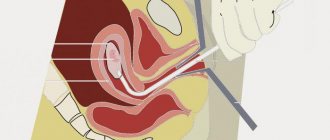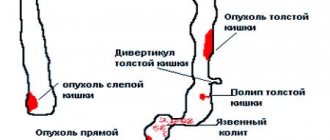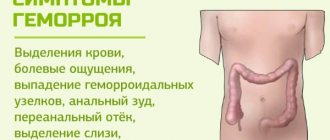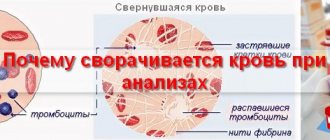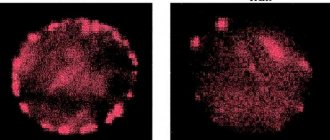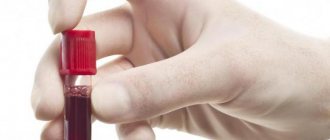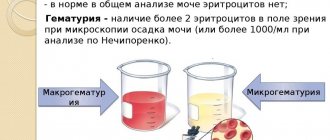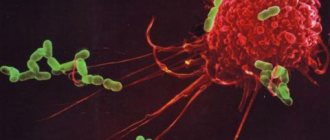Symptoms of the phenomenon
In addition to bleeding itself in the form of systematic or inconsistent discharge, the following symptoms may develop:
- swelling of the navel itself and the skin surrounding it;
- darkening, redness of the skin around the affected area;
- painful sensations when pressing on the corresponding places or constant nagging pain in the lower abdomen (this symptom is especially often observed in women);
- Rarely, fever and weakness may occur.
It is worth understanding that self-treatment of a wound may not provide a therapeutic effect, since bleeding is often a consequence, but not the cause of the pathology. Accordingly, the only correct decision in this case is to consult a doctor.
Treatment options
Bleeding from the navel due to trauma - mechanical impact, piercing - can be treated more easily and quickly. To eliminate symptoms, you need to constantly treat the wound with an antiseptic solution, as well as apply bandages with healing ointments:
- syntomycin emulsion - placed directly into the umbilical cavity along with a piece of gauze 3-4 times a day;
- polymyxin sulfate – used 2 times a day after antiseptic treatment;
- Muliprocin - applied 3 times a day for 1 week;
- Baneocin - can be used up to 4 times a day.
The same ointments can be used in the treatment of omphalitis and infections.
However, any diseases other than injuries often require long-term medical supervision. Doctors may prescribe a course of antibiotics, which should not be refused, as well as surgical intervention on the recommendation of doctors.
During treatment, it is very important to regularly change lotions if they are used. Leaving gauze with ointment in the navel area for a long time can cause it to become wet and make you feel worse.
Treatment must be completed. Even if the symptoms have subsided and the blood from the navel in an adult has stopped flowing, therapy should not be stopped.
Diagnostics
The primary method for diagnosing the disease is palpation of the abdomen.
The specialist establishes the primary diagnosis on the basis of a clinical examination, which includes taking an anamnesis, examination, and palpation (palpation) of tissues. If necessary, the doctor prescribes additional objective studies. To verify the pathogen, several tests are performed:
- Microscopy of pathological secretions, which makes it possible to roughly but quickly establish the origin of the inflammatory process.
- Bacteriological seeding - biological material (usually isolation) is applied to special nutrient media. In the presence of a pathogen, colonies of microorganisms grow on them, which are identified by various properties. The study makes it possible to determine the sensitivity of isolated bacteria to basic antibacterial agents with subsequent selection of the most effective drugs.
- PCR (polymerase chain reaction) - the study involves the detection and identification of the genetic material of pathogens. It has high sensitivity and specificity; it is prescribed in doubtful cases when other diagnostic methods do not make it possible to accurately determine the type of microorganisms.
Prevention of navel redness in adults
Personal hygiene items must be individual
There are many reasons for navel inflammation. To minimize the likelihood of developing various diseases, you must adhere to the following recommendations:
Follow all personal safety rules. You need to take a bath every day with soap, thoroughly clean the area around the navel and the cavity itself.
It is also important to have your own personal hygiene products - a washcloth, a towel and underwear. If severe inflammation is accompanied by a feeling of discomfort or pain, any physical activity should be kept to a minimum, otherwise complications may develop.
It is prohibited to self-medicate and take medications or traditional medicine without the prior approval of the attending physician. Most medications can be purchased without a prescription, which results in many people neglecting to go to a medical facility.
Incorrectly selected medications can cause the condition to worsen. During inflammation of the umbilical area, it is recommended to wear clothes made from natural materials that do not restrict movement. The skin does not breathe through synthetic materials; as a result, the skin sweats and creates a favorable environment for the development of pathogens. Tight clothing rubs against the wound, worsening the condition.
If surgical intervention was required to treat the pathology, during the rehabilitation period you must strictly follow all the instructions of the attending physician. As a rule, therapeutic exercises and strict adherence to a diet are prescribed, with the exclusion of sweet, fatty, spicy and fried foods from the diet.
Navel infections
Umbilical cord bleeding can also be caused by infection. The risk of contracting an umbilical cord infection increases when you have a belly piercing, do not follow personal hygiene rules, or regularly touch your navel with dirty hands. Thus, doctors recommend monitoring the condition and cleanliness of the abdominal area. There are two types of infections which are fungal infections and bacterial infections.
Fungal infections are associated with lesions inside the belly button. One type of fungal infection is yeast infection (candidiasis) , which occurs in patients of all ages. Yeast infections are caused by more than 20 types of candida that can invade the body. To determine the fungus, it is necessary to undergo a series of tests. A fungal infection is characterized by redness, severe itching, fluid secretion and an unpleasant odor. If it has a pronounced external character, I use special creams to eliminate it. But if the infection develops internally, I prescribe oral antibiotics.
Bacterial infection is caused by a number of factors: poor hygiene, cuts and belly piercings make the belly button susceptible to bacterial infections. Symptoms of a bacterial infection usually include fever, redness and pain. Despite this, there are also bacterial infections without visible symptoms. So, in this case, it is best to keep an eye on the condition of your belly button. For preventive purposes, it is recommended to treat the navel area with saline solution if there is a possibility of developing the disease.
Causes
When looking at the causes, we'll focus on what actually causes the infection. So what are some of the common reasons?
Yeast infection
Yeast infection (candidiasis) in humans can be caused by more than 20 different species of candida, with candida albicans being the most common. They affect different parts of the body, especially warm, dark and damp ones, as well as those that have folds, such as between the fingers and toes, under the breasts, in the groin area, navel and others, as this is an ideal environment for the growth of a fungal infection.
Other factors such as tight clothing, poor hygiene, antibiotic use, warm weather, pregnancy, certain medications (such as steroids), post-surgery, and a weakened immune system due to diseases such as diabetes, HIV AIDS, cancer treatment and others, often increase the risk of fungal infection.
Additionally, infants, people with obesity, inflammatory conditions, or those who work in damp conditions are more likely to suffer from fungal infections.
Symptoms
Common symptoms of a yeast infection include itchy rashes, reddish, purple patches around the belly button, flaking and flaking, soreness, white or yellow discharge, and oily pustules (pimples filled with pus). Bleeding may sometimes occur, especially if you scratch an area that is itchy, which may release a foul-smelling fluid.
Diagnostics
To diagnose a yeast infection, a physical examination of the rash is performed, and a scraping is taken for analysis to confirm the cause. General tests can confirm the presence of the fungus, while specific tests identify it as candidiasis. This makes treatment easier.
Treatment
Once tests have confirmed the presence of a yeast infection, you should be diligent about keeping your belly button clean by thoroughly washing your belly button. Since sugar promotes yeast growth, it is best to limit its consumption. Obese people should control their weight and give preference to loose clothing made from natural materials.
The doctor will also prescribe an antifungal ointment, powder, or lotion for treatment. If candidiasis has not spread to other parts of the body, an oral antifungal medication may not be needed.
Streptococcal and staphylococcal infections
A bacterial infection in the belly button is also a possible cause of infection. The causes are usually Staphylococcus aureus (staphylococcus) and Streptococcus pyogenes (streptococcus pyogenes).
The natural environment of the belly button, combined with poor hygiene (touching with dirty hands), sweat, accumulation of dead skin particles, cuts, sebaceous cysts and piercings can make the belly button susceptible to bacteria. Additionally, scratches (due to a yeast infection), a tummy tuck wound, laparoscopy, or surgery can create open sores, thereby making it easier for bacteria to enter.
If infected, some of the symptoms may include redness, itchy swelling, abscess, cellulite, pain around the belly button, and a foul-smelling “discharge that is usually yellowish, greenish, or greyish.”
Mild bacterial infection can be controlled. To do this, it is worth treating the infected area with saline solution and keeping it clean and dry. If the infection is severe, you may want to take antibiotic creams or oral antibiotics. Severe cases accompanied by fever require immediate medical attention.
Infected piercing
Navel piercings can also cause infection, especially if hygiene is poor. Additionally, poor piercing aftercare can lead to infection, which in turn can cause bacterial or fungal infections. There is also a possibility of an allergic reaction to jewelry.
Read more about the symptoms of infection in a navel piercing and how to properly care for it to prevent it here.
Pregnancy does not cause a belly button infection, but it does increase the risk of infection from bacteria and yeast. Mild belly button pain during pregnancy can be caused by stretching of the abdominal muscles and skin, pressure on the piercing, and is not necessarily a sign of infection.
Blood from the navel in men and women: causes, diagnosis, treatment and prevention
Infection
A fungal infection is a likely cause of bleeding or discharge from the belly button. It can create ulcers, which pose a risk of bacterial infection due to favorable conditions such as warmth, moisture and darkness inside the navel.
You are at increased risk of infection if you have a piercing in this area. Poor hygiene can also increase the chance of infection.
Symptoms of infection
Bloody discharge due to infection on the 7th day after surgery to remove the cyst
Your symptoms will vary depending on the cause of the infection. For example, if you have a bacterial infection, they will not be the same as if you have a fungal infection. Common signs and symptoms include:
- sensitivity;
- pain;
- redness or discoloration of the skin in or around the navel;
- itching, tingling or burning;
- a purulent abscess, which may signal a bacterial infection;
- swelling in or around the navel;
- navel, warm to the touch;
- foul-smelling discharge that may be white, yellow, green, gray or brown;
- dizziness;
- nausea;
- vomit;
- bleeding.
You may only have some symptoms, depending on the cause of the infection.
Diagnosis of infection
If the doctor suspects an infection, he will perform a physical examination. He may also collect a sample from the belly button for analysis. The results will help determine the cause of the infection and prescribe effective treatment.
Treatment of infection
If your belly button is infected, your doctor will likely give you lifestyle advice in addition to medication. Lifestyle changes may include:
- wearing loose clothing;
- maintaining personal hygiene;
- keeping the contaminated area dry;
- removing any piercing jewelry.
If you have a yeast infection, an antifungal powder or ointment will be prescribed. Bacterial infections can often be treated simply by rinsing with warm salt water.
Make sure you towel or dry the area thoroughly after rinsing. The doctor may also prescribe antibiotic ointments that should be applied directly to the affected area.
Or oral antibiotics if you have a severe infection.
Umbilical endometriosis
A nodule in the belly button that may leak fluid and blood during your period
Endometriosis only affects women. This occurs when the tissue that makes up the lining of the uterus begins to appear in other organs of your body. This is a rare condition. Primary endometriosis of the navel occurs when this tissue is found in the navel area. This may lead to bleeding from the belly button.
Symptoms of navel endometriosis
Symptoms of primary navel endometriosis may include:
- bleeding from the navel;
- pain around the navel;
- discoloration of the navel;
- swelling of the navel;
- a lump or nodule in or near the belly button.
Diagnosis of navel endometriosis
Your doctor may use an ultrasound, CT scan, or MRI to determine if you have this condition in the belly button area. Primary endometriosis of the navel is observed in 4% of women with endometriosis.
Treatment of navel endometriosis
Your doctor will likely recommend surgery to remove the nodules or lumps. But may also recommend treating this condition with hormone therapy. Surgery is preferred over hormonal therapy because the risk of recurrence after surgery is less than with hormonal therapy.
Cyst
Urachal cyst
A urachus cyst is one of the rare causes of this problem. The urachus or urinary duct is a tube that connects the fetal bladder in the womb to the umbilical cord. Even before birth, this tube normally closes, but in some cases it does not close completely.
In such people, at a later age, a cyst may form in the unclosed urachus - a formation filled with fluid. If it becomes infected, it can cause cloudy or bloody fluid to leak from the belly button.
Other symptoms of a urachus cyst include pain in the abdomen, pain when urinating, and fever.
A sebaceous cyst, if damaged, can cause bleeding
Sebaceous cysts on the skin are also a possible cause of bleeding from the navel in cases where they are located in the navel area and become damaged. These formations are a soft lump in the skin filled with caratine, which does not pose any danger. However, a sebaceous cyst can be uncomfortable, especially when it bleeds and goes untreated.
If an infected cyst is causing discharge from the belly button, treatment may be a little more difficult. The first step is to eliminate the infection itself, usually with antibiotics. The cyst will probably also need to be completely drained. Doctors may also recommend laparoscopic or laser surgery to remove the entire cyst, including the root, and significantly reduce the chance of it returning.
Surgical procedures
.
During laparoscopic surgery, a small incision is made near the navel, after which temporary bleeding may occur.
Often abdominal surgeries end up causing this problem. Especially those in which the navel area was used as an entry point for laparoscopic surgical instruments (trans-umbilicus laparoscopy).
Belly button piercing
Inflamed navel piercing One of the reasons for bleeding from the navel remains its piercing. If the piercing is done incorrectly or poorly cared for, the area becomes susceptible to infection.
Learn more about what bleeding and pain is acceptable after a belly button piercing and how to properly care for it to avoid infection.
Source: https://ocrb.ru/osteohondroz/pochemu-krovit-pupok.html
Causes
The causes of blood from the navel may be diseases of the navel itself. In addition, some disorders and pathologies in the body may manifest themselves as bleeding from the navel. Bleeding from the navel can be of different types: bloody, purulent, serous.
In adults
This pathology is considered to be most common among newborns, but nevertheless, there are cases when blood discharge from the navel occurs in adults.
Blood from the navel in an adult may indicate various pathologies. The most common inflammation of the skin of the umbilical fossa, which in medical practice is called omphalitis. This disease is characterized by purulent and serous discharge from the navel of varying degrees. The causative agent of this disease is microorganisms and fungi.
Omphalitis
There are three forms of omphalitis: the simplest is a weeping navel, the fluid released from the navel dries out and forms crusts. The second stage is called the phlegmonous form, in which inflammation of the surrounding tissues occurs. This condition is accompanied by high fever and deterioration in general health. In the third stage of omphalitis (necrotic form), inflammation penetrates inside and can cause peritonitis. At the same time, ulcers form and bruises appear.
Blood from the navel in adults can also be released during the healing of omphalitis. When treating an inflamed navel, granulation tissues that have grown during the illness may be damaged.
Fistulas, congenital or acquired, can cause bleeding of varying intensity from the navel. At the initial stages, the discharge is usually transparent, but as inflammation develops, pus and blood may appear in the discharge from the umbilical cord vessels.
In women, bloody discharge from the navel may indicate a disease such as navel endometriosis. With this disease, the endometrium grows into the anterior abdominal wall and then blood discharge appears. In this disease, blood from the navel is released most intensely during the menstrual cycle.
With a congenital anomaly called a urachus cyst, which occurs during fetal development, bleeding from the navel is often observed. The difficulty in diagnosing this pathology lies in the fact that this disorder only appears with age.
A girl may also experience bleeding from her navel during installation of various jewelry. Most often this happens when the piercing technology is violated or the antiseptic treatment of the navel area is insufficient.
Piercing
In newborns
The reasons for the appearance of blood from the navel of a newborn may be the following: firstly, the healing of the umbilical wound has not yet completed. For each newborn, this process occurs individually; in some, healing occurs completely within a few days; in others, it can continue during the first month of life.
Bloody discharge from the navel in a child can be caused by frequent and prolonged abdominal tension. In babies, this condition occurs with frequent and severe crying, constipation or coughing. Particular care must be taken when using diapers when the navel is healing; it is necessary to avoid rubbing this area with diapers or use diapers with a special recess for the navel.
Causes of the phenomenon
When it comes to ensuring comfort and safety for a baby, there are no trifles, but during the first month of a baby’s life, the condition of the newborn’s umbilical area deserves special attention.
If the bleeding stops within 5 minutes, there is no cause for concern. But a prolonged non-healing wound can be a sign of infection. To avoid serious consequences, young parents need to know about the causes of wound bleeding in the navel area and ways to eliminate the problem.
Before birth, the fetus is connected to the mother by an umbilical cord, consisting of three large vessels.
For all 9 months, she played a vital role in providing the fetus with all the substances necessary for intrauterine development. But with the baby's first breath, its functions are completed.
After birth, obstetricians cut it off, leaving a piece 3-5 mm long, twist it with a tourniquet, bandage it with surgical threads or secure it with a plastic clothespin.
If the umbilical cord is cut correctly, normally this piece of the umbilical cord will fall off on the 3-7th day. Before the navel is finally formed, a wound appears in its place. Up to 3 weeks, minor bleeding from the wound of the future navel is considered normal.
This is an average, allowing deviations in any direction. If the placenta is thick, the baby's belly button may be larger than usual. It will heal more slowly, since the wound is larger in diameter.
Likewise, a paper clip on the stump can dry out on the third day while still in the maternity ward, and sometimes “embarrasss” young parents already at home.
Experts recommend monitoring your newborn's navel very carefully. At the first visit to the baby, the wound will definitely be treated by a visiting nurse.
The ideal treatment for an umbilical wound is the complete absence of any manipulation and maximum attention to the newborn.
If blood appears in the discharge from the navel, pulsation is noticeable in the area of the umbilical wound, touching the umbilical stump provokes crying and the baby’s condition is suspicious (increased temperature of the whole body or the umbilical area), you should definitely consult a pediatrician and follow all his recommendations for treating the wound. Until the navel heals completely, this procedure will be the same norm for the mother as cleaning her ears or changing diapers.
For the hygiene procedure you need to prepare:
- Sticks with cotton wool;
- Sterile napkin;
- Pipette;
- Antiseptics (brilliant green, hydrogen peroxide).
Disinfecting the navel does not cause any particular difficulties.
- First, you need to pour a little hydrogen peroxide into the wound with a pipette. It foams, but the baby reacts to this procedure normally, since he does not feel pain. You can use clean fingers to stretch the navel a little. Applying peroxide to the wound usually stops bleeding.
- When the crusts become limp, they must be carefully removed from the wound with a cotton swab. It is important to remove all crusts, even those in hard-to-reach places.
- Now you can lubricate the wound with brilliant green. To prevent medications from accidentally getting on the face of a restless child, you need to work carefully; you can cover the entire stomach with a sterile napkin. Don't waste time for fear of hurting your child. You need to act quickly, but carefully.
Disinfection of the umbilical area should be done only once, every day, but not more often. The less you injure it, the faster it heals. With frequent use of aggressive hygiene products, the wound remains bare and does not have time to dry out.
Combine treatment with bathing. Once wet, the crusts become soft and easier to remove.
The traditional “green stuff” is now being replaced with a special product for newborns - chlorophyllipt. An alcohol-based medicine is suitable for disinfecting the navel. The advantage of the new drug is that the treated skin does not stain. This is important for redness and swelling, as uncolored defects are easier to notice.
Try to keep the navel area constantly open: in the air, epithelization of the wound occurs faster. Yes, and hardening will benefit the baby.
After an air bath, the navel still has to be protected, since the green stains practically cannot be washed off. You can use a clean gauze pad and a fixing mesh bandage for this. When changing the diaper, you need to make sure that the bandage remains in place. Clothes or diapers must be perfectly clean and loose so as not to injure the area where blood vessels accumulate.
You cannot cover your navel with a band-aid. Diapers need to be wrapped or purchased special ones, for infants, with a recess in the navel area.
If the wound is still bleeding, or the clothespin that clamps the stump does not fall off on the 10-14th day, bathing should be temporarily stopped. Individual parts of the body can be wiped with a soft sponge, avoiding the umbilical wound area.
It is not always possible to quickly determine the true cause of bleeding, so even with proper care, complications sometimes develop. If a newborn exhibits at least one of the listed signs, you should urgently visit a pediatrician.
- Weeping navel for two weeks. Final healing can last up to 3 weeks, but by the 7th day the area should be completely dry. If healing is delayed, the pediatrician may prescribe dioxidin to treat the wound. This antiseptic will destroy the infection if it has already appeared in the navel.
- Suppuration in the navel area can be identified by yellow-green discharge with a characteristic odor. Antiseptic drugs are also prescribed for treatment.
- Bleeding in the navel area can be caused by an accidentally ingested foreign body, which must be removed by the surgeon; in any case, before visiting the pediatrician for an accurate diagnosis, it is impossible to treat the wound with dyes (brilliant, iodine, potassium permanganate) that lubricate the clinical picture.
- Inflammation of the umbilical ring and cavity, redness of the skin, swelling of the entire area. Such symptoms may indicate the development of omphalitis, a serious inflammation that provokes peritonitis of the abdominal cavity with blood poisoning. Urgent treatment with antibiotics in a hospital setting is required.
- With long and poor healing, granulations may develop, which look like a pink ball on a stalk inside the navel. The tangle of capillaries rapidly grows, the abdomen turns red. Such signs indicate the occurrence of navel granuloma (fungus). The disease can be treated at home, following all the pediatrician’s recommendations. Wash the wound with hydrogen peroxide and treat it with potassium permanganate and brilliant green (depending on skin type) to dry the navel.
- When crying or coughing, the baby's navel enlarges and can reach the size of a walnut. It often appears when the baby is in an upright position. A problem arises in both girls and boys at any intensity of screaming. To clarify the diagnosis, you should consult a pediatric surgeon. If it's a hernia, it may go away on its own. Or, upon reaching 3 years of age, it is removed during surgery. Frequently laying the baby on his stomach (after the navel has completely healed, preferably after 3 months), tummy massage and special gymnastics helps to cope with a hernia. All recommendations can be obtained from a pediatric surgeon.
- Prolonged bleeding occurs in babies with very weak immunity and poor blood clotting. Fragility of blood vessels leading to bleeding indicates infection. When the body is weakened, healing is delayed. In such a situation, a comprehensive examination is carried out.
Healing the navel is a responsible process, because through the channel where the placenta communicates with the fetal bloodstream, infection of the body is possible. Don't be afraid to unduly worry your doctor about bleeding in your newborn. The use of any medications should be agreed upon with doctors, and not with mothers on thematic forums. The sooner the cause is determined, the easier it is to deal with the problem.
The causes of blood from the navel may be diseases of the navel itself. In addition, some disorders and pathologies in the body may manifest themselves as bleeding from the navel. Bleeding from the navel can be of different types: bloody, purulent, serous.
In adults
This pathology is considered to be most common among newborns, but nevertheless, there are cases when blood discharge from the navel occurs in adults.
Blood from the navel in an adult may indicate various pathologies. The most common inflammation of the skin of the umbilical fossa, which in medical practice is called omphalitis. This disease is characterized by purulent and serous discharge from the navel of varying degrees. The causative agent of this disease is microorganisms and fungi.
Omphalitis
There are three forms of omphalitis: the simplest is a weeping navel, the fluid released from the navel dries out and forms crusts. The second stage is called the phlegmonous form, in which inflammation of the surrounding tissues occurs. This condition is accompanied by high fever and deterioration in general health.
Blood from the navel in adults can also be released during the healing of omphalitis. When treating an inflamed navel, granulation tissues that have grown during the illness may be damaged.
- Omphalitis is an inflammatory process of the skin that is directly adjacent to the navel. Usually the processes are infectious in nature - they are excited by microscopic fungi and bacteria. Along with blood, secretions of different consistencies are formed.
- Damage to enlarged granulation tissue is a complication of omphalitis. When it occurs, then granulation tissue grows to cleanse the navel wound. As a result, it increases, which leads to its mechanical damage, which is why bleeding is observed.
- Congenital or acquired fistulas are a rather rare type of disease. The reason for the phenomenon is that inflammatory processes occur in the abdominal cavity with the release of pus. If dead ulcers appear, they can come out through the umbilical region, which provokes the appearance of blood. In the case of congenital fistula, the release of secretions is associated with hormonal imbalance in the body.
- Endometriosis occurs when the cells of the uterine lining grow due to hormonal changes. They may appear in unusual areas, such as under the skin of the belly button. This leads to its mechanical ruptures and bleeding.
- Finally, one of the common reasons is the consequences of an incorrectly done navel piercing. The skin may become damaged and, accordingly, blood discharge will appear.
An adult's belly button bleeds
As a rule, the umbilical wound heals during the first month of a newborn's life. But in medical practice, doctors often encounter situations where the umbilical fossa oozes and an adult’s navel bleeds. The most common reasons why blood appears from the navel in an adult are:
- omphalitis;
- the presence of damage to overgrown granulation tissue;
- presence of umbilical fistula;
- the occurrence of navel endometriosis;
- belly button piercing.
Omphalitis - inflammation of the skin of the umbilical fossa
Omphalitis refers to inflammation of the skin in the umbilical fossa area. This disease can be caused by various types of fungi or opportunistic microorganisms. The type of discharge from the navel depends on the nature of the inflammation and the pathogen. They can be serous, purulent, hemorrhagic, putrefactive with gas bubbles, cheesy.
If measures are not taken to eliminate the problem in time, the infection will spread further along the umbilical vessels, which threatens the development of periarteritis and periphlebitis. At the same time, dense, painful cords will begin to appear in the deep layers of the skin, having a purple color and extending from the navel.
When pathogenic microorganisms penetrate the subcutaneous tissue, they cause the development of erysipelas or gangrene of the anterior abdominal wall, and in the case of damage to the peritoneum, local or widespread peritonitis, which is a direct threat to human life.
At home, the first stage of omphalitis can be cured by treating the bleeding navel with a 3% solution of hydrogen peroxide (or 0.02% solution of furatsilin), and then lubricating the wound with brilliant green.
Damage to overgrown granulation tissue
The navel in an adult may bleed due to damage to the overgrown granulation tissue at the site where omphalitis heals. Normally, granulations help ensure that the wound is cleaned and recovery occurs as quickly as possible. But in the event of chemical or mechanical damage, blood may begin to appear from very thin and delicate superficial vessels.
Navel fistulas
Another reason for bleeding from the navel of an adult is congenital and acquired fistulas. A fistula is a pathological canal connecting the skin in the navel area with internal organs. An acquired fistula is formed in the event of a complication of purulent processes in the abdominal cavity, when an inflamed or dead abscess appears. The very exit of the fistula into the human navel area is accompanied by the release of pus and sometimes blood along with it. This phenomenon is often observed in the case of strangulated umbilical hernia.
Congenital fistulas become inflamed at any age with the same symptoms as in the case of acquired fistulas. Their appearance is associated with a disruption of the normal course of embryogenesis. With congenital fistulas, a small hole near the navel is usually noticeable immediately after the newborn is born. Discharge from it in its normal course is mucous, slightly serous, but when an inflammatory process occurs, it can begin to bleed.
The fistula canal is usually excised when the patient reaches 3 years of age, but if the fistula is blocked and, as a result, the outflow of contents from the hole is impaired, inflammation may begin, requiring immediate surgical intervention.
Endometriosis of the navel
Umbilical endometriosis refers to the growth of the endometrium in the tissue of the anterior abdominal wall, in which bloody discharge appears from the umbilical fossa. This disease is typical only for women. The cause of navel endometriosis is considered to be the transfer of the endometrium from the uterine cavity into the peritoneal tissue through the lymphatic vessels. Bleeding from the navel most often occurs before menstruation, within a few days after it ends, or during it.
May be accompanied by severe pain. Treatment of this pathology is mainly surgical: patients undergo laparoscopic surgery under general anesthesia, as a result of which foci of endometrial growth in the navel, peritoneum, and also in the pelvic organs are excised. In some cases, women may be prescribed additional hormonal treatment to help stop menstruation for a while (introduction to artificial menopause).
Belly button piercing
If, when piercing (puncture) the umbilical fossa, the manipulation technique is violated or the rules of asepsis and antisepsis are not carefully followed, some patients may experience damage to the blood vessels in the umbilical area, which subsequently leads to the development of omphalitis and bleeding from the navel
In any case, if blood is released from the navel of an adult, it is imperative to visit a doctor (surgeon).
Causes of discharge in newborns
During the period of drying out of the umbilical cord remnant, it is necessary to monitor it. Unfortunately, it can become untied, then blood begins to bleed, and there is a high risk of infection, which can lead to more complex inflammatory processes and diseases.
Navel hygiene is very important in the first days of life, right up to its healing. Using a cotton swab, the navel area is treated with hydrogen peroxide, while pushing apart the tissue of the nodule. Don't be afraid, this procedure is practically painless for the child. If a foamy reaction is noticeable, it means there is blood inside. In the first week, or even the first eight days, this is a normal healing process. If the skin around the navel is swollen, has a reddish tint and is bleeding, an immediate visit to a neonatologist is recommended. The doctor will make a diagnosis in order to exclude the occurrence of acute infection - omphalitis.
Newborns may have an unpleasant putrid odor from the navel - this is also an alarming indicator. Parents should treat it with a weak alcohol solution and immediately take the child to the doctor.
A child's navel requires care - obligatory wiping with a weak alcohol solution, hydrogen peroxide, and antiseptics. Arnica powder is ideal; in addition to being antiseptic, it also has healing properties. The wound is covered with a small piece of sterile bandage and a special mesh is placed on the tummy to secure it.
There are cases when blood comes from the navel of a newborn for several days. The symptoms are not very good, this is a signal for a visit to a neonatologist. Such manifestations are possible with umbilical granuloma - fusion of connective tissues and blood vessels, and their growth at the junction with the umbilical “tail” occurs rapidly. Usually doctors burn this area with silver nitrate, thus stopping the growth of connective tissue cells.
There are two types of bleeding from the navel:
- Vascular - occurs as a result of an incorrect or poorly formed umbilical cord nodule in babies. Sometimes there is blood as a reaction to increased pressure in the pulmonary circulation during hypoxia, with congenital heart defects, and also blood comes from a granulating wound;
- Diseases of sepsis, hemophilia, thrombocytopenic purpura.
If there is severe bleeding from the belly button, seek immediate medical attention. First of all, local hemostatic (hemostatic) agents are applied to the navel, for example a bandage with gamma globulin or moistened with thrombin. In addition, ascorbic acid is administered, a blood transfusion is carried out to the newborn, and intramuscular injections of Vikasol are given.
The main causes of fluid discharge from the navel in an adult
Most often, those who have pierced themselves face the problem of a weeping navel.
As a rule, the cause of inflammation is a fungal or bacterial infection, for example, Pseudomonas aeruginosa and Escherichia coli, streptococci, staphylococci. However, certain prerequisites must also exist for infection:
- Increasingly, young women who have had piercings are faced with the problem of navel inflammation. If the procedure is carried out with poorly processed instruments or all necessary measures for rapid wound healing are not followed, complications may develop.
- Formation of a fistula near the umbilical ring. As a rule, fistulas are a congenital abnormality, the formation of which is caused by non-closure of the urinary or vitelline duct. If a vesico-umbilical fistula has formed due to a patent urinary duct, urine will be separated. If an intestinal-umbilical fistula has formed, the discharge will most likely be intestinal.
- Violation of the integrity of the skin, navel wounds with improper care until complete healing serve as a direct gateway for pathogens into the human body.
- Also, the cause of inflammation can be the physiological features of the structure of the navel. For example, if the umbilical canal is deeply retracted or too narrow, sebaceous gland secretions and dying epidermal cells accumulate in it. In this case, if the rules of personal hygiene are not observed well enough, the navel may become inflamed.
The clinical picture manifests itself in redness and swelling of the tissues, and as the disease progresses, serous discharge appears. In severe forms of omphalitis, purulent discharge interspersed with blood is observed, body temperature rises and the navel itself changes its shape - it becomes hot to the touch and convex. A particularly hot area is the epicenter of the inflammatory process. The wounds are covered with a protective crust, under which purulent masses accumulate.
In medicine, there are 3 forms of omphalitis, each of them has its own symptoms.
| Simple form (wet navel) | Phlegmonous form | Necrotic (gangrenous) form |
The general well-being does not suffer. |
|
|
The necrotizing form of omphalitis is extremely rare and affects people with weakened immune systems.
Causes of blood
Omphalitis is an inflammation of the umbilical fossa, which may be accompanied by swelling or the appearance of blood. The disease is caused by various types of bacteria or pathogenic organisms. The intensity of bleeding and the degree of infection depend on the nature of the inflammation and the pathogen. Depending on this, the nature of the discharge from the navel is distinguished. The following may be observed: purulent formations, hemorrhagic, vesicular, curdled and others. If the cause is not identified in a timely manner and the consequences of the inflammatory process are not eliminated, there is a possibility of complications.
One of the most serious side effects from an infectious lesion of the navel is the development of periarteritis and periphlebitis. If you do not ignore the symptoms, particles harmful to the body enter the abdominal cavity, affecting its walls. Perionitis is a threat to the patient’s life, so at the first signs of inflammation you should consult a doctor. For stage 1 omphalitis, the wound is treated at home with hydrogen peroxide and brilliant green.
Research suggests that prematurity and low birth weight may play a role in the development of belly button infections, along with a weakened immune system and genetic defects.
The main cause of this infection is exposure to bacteria (such as streptococci, staphylococci and tetanus) during childbirth, when the umbilical cord contracts after birth or a few days later. Proper home care after childbirth can reduce the risk of omphalitis, so it is important to follow your doctor's advice about postpartum belly button care.
Symptoms may also include abdominal swelling, foul odor from the infected area, fever, bleeding around the umbilical cord, irritability, lethargy and decreased activity. Since any of these symptoms can occur at an early or advanced stage, it is important to see a doctor immediately if omphalitis is suspected.
Standard treatment requires hospitalization for several days for observation and antibiotics, although surgery may be required in some more serious cases to remove the infected area of the belly button.
In addition to fungal infection, which is the main cause of purulent formations, the list of other prerequisites includes congenital pathology, when a person develops a fistula in the navel area. If the structure of the navel is very retracted and narrow, there is a possibility of accumulation of dying cells and secretion of sebaceous glands. If you ignore personal hygiene, the risk of developing ulcers increases. If skin defects or wounds form in the navel area, they should definitely be treated so that infection cannot develop.
Clinical picture
A mark of the place that once connected the body of mother and child, in the form of a depression with a nodule. There are no openings into the abdominal cavity, except for the unhealed navel of newborns; the area belongs to the skin and does not have mucous membranes. The only liquid that is present normally is sweat. Pathological conditions may be accompanied by the following symptoms:
- Thick white curdled masses;
- Yellow-green purulent discharge;
- Serous substance - liquid like water in significant quantities can have a dirty tint;
- Bloody issues;
- Unpleasant odor;
- Hyperemic, that is, hot, red and swollen tissues in this area;
- Itching and pain;
- Rash and sores;
- Dried crusts are scabs.
Symptoms of a serious condition when the pathological process moves into the inner part of the abdominal wall:
- Heat;
- Blue and purple spots in the navel area;
- Acute pain;
- Open sores;
- Symptoms of severe intoxication are nausea, vomiting, headache.
Discharge from the umbilical stump of a newborn
With babies, everything is a little different, because the hole in the peritoneal area has not yet healed. The umbilical cord had many vessels and channels for removing waste from the bladder and intestines. Infection is highly likely and leads to inflammation. The symptoms are:
- Clear vascular pattern on the abdomen;
- The discharge is serous or purulent;
- The child is lethargic, eats poorly, cries a lot and spits up often.
Thrombophlebitis of the umbilical vein occurs, then blood will appear from the unhealed hole when stroking the tummy. The abdominal wall is always tense.
Transparent discharge in large quantities may be a sign of an unclosed canal, which was intended for intrauterine urine excretion.
Omphalitis
Inflammation in the navel area caused by staphylococci or E. coli. Occurs due to mechanical damage to tissues and subsequent failure to comply with hygiene standards. Symptoms change depending on the stage.
- Catarrhal. Sulfur with blood or pus is released from the wound. Swelling and redness occurs. There is no deterioration in health. A slight increase in temperature is possible.
- Phlegmonous. Inflammation spreads to surrounding tissues. They thicken and swell. The affected areas rise above the surface of the abdomen. The skin around the navel turns red and becomes moist. The venous pattern is visible. There is a fever.
- Necrotic. Occurs in patients with weakened immunity and is characterized by penetration of infection deep into the internal organs. The skin turns blue, severe pain is present, and the temperature drops sharply.
Antiseptic solutions, antibiotic ointments, and physiotherapy are used for treatment. The formed abscess is opened surgically. Antibacterial drugs are also prescribed.
Main causes and symptoms
Growth in the navel
Sometimes the fluid that comes from the umbilical cavity is not a sign of a serious illness. Due to profuse sweating, small serous crusts appear in the navel, sometimes accompanied by the release of purulent contents.
In very rare cases, tissue begins to grow in the navel, resulting in a small mushroom-shaped growth. Such tumors are not life-threatening. To cure them, antiseptic medications and powders are used.
Only a doctor can determine why an adult’s navel gets wet. However, you can guess what causes the discomfort based on additional signs.
Omphalitis
Inflammation in the navel develops due to damage to the skin, where a bacterial or fungal infection penetrates. Sometimes the disease is associated with the narrowness of the cavity, where, due to insufficient hygiene, dirt accumulates, which is a favorable environment for the development of pathogenic microorganisms.
With simple omphalitis, a person’s navel is wet, a crust and a nasty smell may appear. There are no other unpleasant symptoms. But it is necessary to stop the inflammatory process as quickly as possible. Otherwise, there is a risk of developing phlegmonous and necrotic omphalitis.
The first type of disease is characterized by the following symptoms:
- inflammation of the tissues in the area around the navel;
- redness and thickening;
- painful sensations;
- discharge of pus;
- increase in body temperature.
The development of phlegmon of the peritoneal wall is possible.
If you continue to refuse treatment, a gangrenous or necrotic form of the disease may develop. The infection will penetrate into the abdominal cavity, leading to necrosis and detachment of dead tissue.
Urachal cyst
It occurs due to improper development of the urinary canal - urachus. It usually manifests itself in childhood, more often in boys, but sometimes it does not show itself for a long time. The defective duct has a cavity that is filled with waste products. At a certain point, they begin to exit through the hole in the navel. An infection that enters the body will cause the cyst to fester.
Umbilical fistula
This deviation is quite rare and in most cases is congenital. But sometimes acquired fistulas are observed. The reason for their formation is intestinal trauma or pinching of the umbilical hernia. They can also occur after prolonged inflammation of the anterior wall of the peritoneum, when a purulent abscess or skin lesion - a boil - is opened through the umbilical fossa.
External manifestation of endometriosis in the navel
Characteristic signs of a fistula:
- redness and irritation of the skin;
- purulent discharge, sometimes mixed with urine and feces;
- disgusting smell;
- heat.
If you notice any of the above symptoms, consult your doctor immediately.
Female pathologies
If a woman secretes fluid from the umbilical cavity with bloody streaks, this is a symptom of long-standing growth of the endometrium.
Another common reason why the fairer sex’s navel oozes moisture is candidiasis. With this disease, not only a cheesy discharge occurs, but also redness of the skin with itching, and a characteristic rotten smell. Candidiasis of the navel often occurs in pregnant women as a result of hormonal imbalance, as well as due to neglect of hygiene, the use of antibiotics or hormonal contraceptives.
Inflammation of the navel as a result of infection
Infected children suffer from severe oral lesions, which prevents them from eating normally. As a result, they lose weight and suffer from developmental delays. With diabetes or problems with the immune system, such symptoms are likely to appear in men.
Sometimes a woman’s navel area becomes wet as a result of an unsuccessful piercing. The umbilical fossa becomes inflamed due to infection when performing a puncture with unsterile instruments and dirty hands, as well as during healing due to poor hygiene and care. In this situation, it is not the navel itself that leaks and turns red, but the puncture area. Clear discharge without signs of inflammation may indicate an allergy to metal. In such a situation, it is necessary to replace the jewelry and take an available antihistamine medication.
Postoperative sutures
Incisions and punctures in the peritoneal wall after surgery may become infected due to improper or untreated treatment. Transparent, odorless discharge with minor impurities of ichor is the norm. But if they are purulent, whitish or yellowish, and the stomach hurts, there is clearly inflammation. This condition is fraught with the development of peritonitis and sepsis; immediate consultation with a doctor is required.
Dried blood in the navel - is there any cause for concern?
Bleeding other than menstrual bleeding is never normal. And if there is bleeding from the navel, this is a reason to seriously think about your health. In some cases, the problem can be dealt with on your own, but if pain and pus appear, self-medication is out of the question.
After punctures or other mechanical damage, the integrity of the blood vessels is compromised. Sometimes this may not be noticed. And if the discharge is not too abundant, over time, dried blood appears in the navel. If such a phenomenon is detected, you need to rinse the hole and treat it with hydrogen peroxide. Maintaining cleanliness and timely asepsis will help avoid inflammation.
There are several diseases that cause bleeding in this area. When one of them occurs, the problem is not easy to get rid of. In addition, other symptoms will appear that require immediate medical attention.
Extragenital endometriosis
A pathology found only in women. The cells lining the inner surface of the uterus penetrate the peritoneum through lymph or during gynecological operations.
This can also occur when the uterus is bent, when the outflow of menstrual blood is disrupted, and endometrial particles move in the opposite direction and are thrown into the abdominal cavity.
Patients experience bleeding from the navel during menstruation and cyclic pain. Patients are indicated for surgery and hormonal therapy.
Oncology
Cancer rarely occurs directly in the belly button. Usually the tumor affects it through metastases from nearby organs. In this case, lumps, growths or bleeding ulcers form in the umbilical area. There may also be pus discharge. If malignant neoplasms occur, external manifestations are eliminated, surgery is performed, and chemotherapy is prescribed.
Urachal cyst
A cavity with mucous contents that forms in the urinary duct when it is not closed. This is a congenital pathology, but it can be asymptomatic for a long time. It is often found in adults who have undergone surgery or have been exposed to an infection.
The cyst becomes inflamed and increases in size. The process is accompanied by severe pain, swelling of the tissues, and redness of the skin. The tumor puts pressure on the intestines and bladder, causing discomfort when urinating, increased gas formation, and constipation.
The temperature also rises. When the capsule ruptures, pus comes out. Dried blood may be found in the navel. With such a diagnosis, treatment begins with relieving inflammation by antiseptic treatment of the affected areas and irradiating them with ultraviolet light.
The internal pus is then drained and the cyst is surgically removed.
Fungus
A mushroom-shaped tumor consisting of granulation tissue cells. It grows on healing wounds.
The pathology usually occurs in newborns, but can also affect adults who wear piercings or have a history of surgery or injury.
Granuloma is an inflammation that is relieved by cauterization, treatment with antiseptics, and antibiotics. In some cases, surgery is indicated.
Fungus
Failure to maintain hygiene, especially with increased sweating, leads to the proliferation of pathogenic fungi. People with weakened immune systems are also at risk.
The inside of the navel is moist and warm, so microorganisms feel very comfortable there. They provoke the appearance of liquid and purulent discharge. Severe itching causes constant scratching. The scratches bleed.
Local antifungal medications and careful hygiene of the affected area help treat the disease.
Even if the blood from the navel does not gush in different directions, but forms a small dried crust, you should seek medical help. Mechanical injuries increase the risk of inflammation, which provokes even more serious problems. There are other dangerous causes of bleeding.
Source: https://dermatovenerologiya.com/krov-v-pupke.html
Treatment and prevention
Treatment of bleeding from the navel in adults can be carried out with medications, antibacterial therapy, and treatment of inflammation sites with various drugs. In some particularly difficult cases, surgical intervention is necessary.
In what cases should you consult a doctor if your child’s belly button does not heal? In this case, it is necessary to keep in mind that by the third week after the birth of the child, the umbilical wound should heal completely. If the navel has not healed, this is a reason to consult a doctor. Parents should be especially concerned about prolonged bleeding from the navel. If the baby’s navel also protrudes unusually, then consultation with a neonatologist is necessary.
Healing of the umbilical wound in a newborn
Measures to prevent bleeding from the navel are compliance with the following rules:
- Maintaining personal hygiene for both children and adults. The navel needs to be regularly cleaned of accumulated dirt, best done while taking a bath or shower. It is enough to wash the navel with soap and water; this must be done very carefully so as not to damage it.
- If crusts have formed on the navel, but there are no discharges, then you can lubricate the navel with any cosmetic or vegetable oil, and then carefully remove the softened crusts using a cotton swab.
- If there is a piercing in the navel, it is not recommended to use products containing alcohol for treatment and cleansing.
When treating a newborn's navel, precautions must be taken, especially if the umbilical wound has not yet healed. It is recommended to treat the navel with hydrogen peroxide, brilliant green or a diluted solution of potassium permanganate
The navel is treated using cotton pads and a pipette. Using a pipette, take a few drops of a disinfectant solution and drop it into the navel, then blot the navel and the area around it with a dry cotton pad. Carefully ensure that no blood discharge appears from the umbilical wound.
But what to do if blood from the navel begins to flow more intensely? In this case, to stop bleeding from the navel, it is recommended to treat the navel with 3% hydrogen peroxide. If the navel bleeding cannot be stopped, consult a doctor immediately.
Prevention and precautions
You can avoid the appearance of blood from the navel, as well as diseases that cause this symptom, by remembering the rules of prevention:
- Maintain personal hygiene. Regular showering helps wash away bacteria from the body, improves your mental state and helps you relax. It is important to constantly wash your hands and clothes, and change your underwear regularly.
- Taking care of your piercing. To prevent navel piercing from causing problems, the piercing must be jewelry - jewelry is not allowed. Only precious metal will prevent the formation of irritation and ulcers.
- Caring for your place of residence. You need to regularly clean your apartment and keep clothing storage areas clean.
- Rejection of bad habits. Cigarettes and alcohol worsen the immune system and destroy the nervous system, and also lead to gastrointestinal diseases. Also a bad habit is abnormal sleep of less than 8 hours a day.
Be sure to watch your diet, make it balanced, with plenty of fruits and vegetables. It is important to exclude fast food, an abundance of sweets and carbonated drinks.
Competently following a correct lifestyle will prevent the appearance of blood in the navel. If this symptom occurs, you should immediately consult a doctor and undergo the recommended treatment.
Treatment of navel discharge
Treatment for navel discharge depends on its cause. In local therapy of simple omphalitis (in both newborns and adults), the navel is treated with antiseptic drugs such as an alcohol solution of iodine (10%), an alcohol solution of brilliant green (2%), a solution of hydrogen peroxide (3%), a solution of potassium permanganate (5%), silver nitrate solution (2%).
It is also recommended to apply the following ointments:
- Synthomycin liniment (Synthomycin emulsion) - applied to the navel area, a regular bandage is applied on top (possibly with compress paper) - 3-4 times a day.
- Polymyxin-m sulfate - applied in a thin layer to the affected area after removing the pus - 1-2 times a day.
- Baneocin (Bacitracin + Neomycin) – applied 2-4 times during the day. Redness, dry skin, skin rashes and itching may occur at the site of application of the drug. Pregnant women are not recommended to use.
- Bactroban ointment and cream (Mupiprocin) - applied three times during the day, the course of treatment is 7-10 days. The ointment is not used to treat children under 2 months, and the cream is not used for children under one year of age.
Treatment in the case of phlegmonous or necrotizing omphalitis is carried out in a hospital setting - with injections of antibiotics. In severe situations, they resort to surgical intervention with the installation of drainage to remove pus.
Endometriosis of the navel
Umbilical endometriosis refers to the growth of the endometrium in the tissue of the anterior abdominal wall, in which bloody discharge appears from the umbilical fossa. This disease is typical only for women. The cause of navel endometriosis is considered to be the transfer of the endometrium from the uterine cavity into the peritoneal tissue through the lymphatic vessels. Bleeding from the navel most often occurs before menstruation, within a few days after it ends, or during it.
May be accompanied by severe pain. Treatment of this pathology is mainly surgical: patients undergo laparoscopic surgery under general anesthesia, as a result of which foci of endometrial growth in the navel, peritoneum, and also in the pelvic organs are excised. In some cases, women may be prescribed additional hormonal treatment to help stop menstruation for a while (introduction to artificial menopause).

